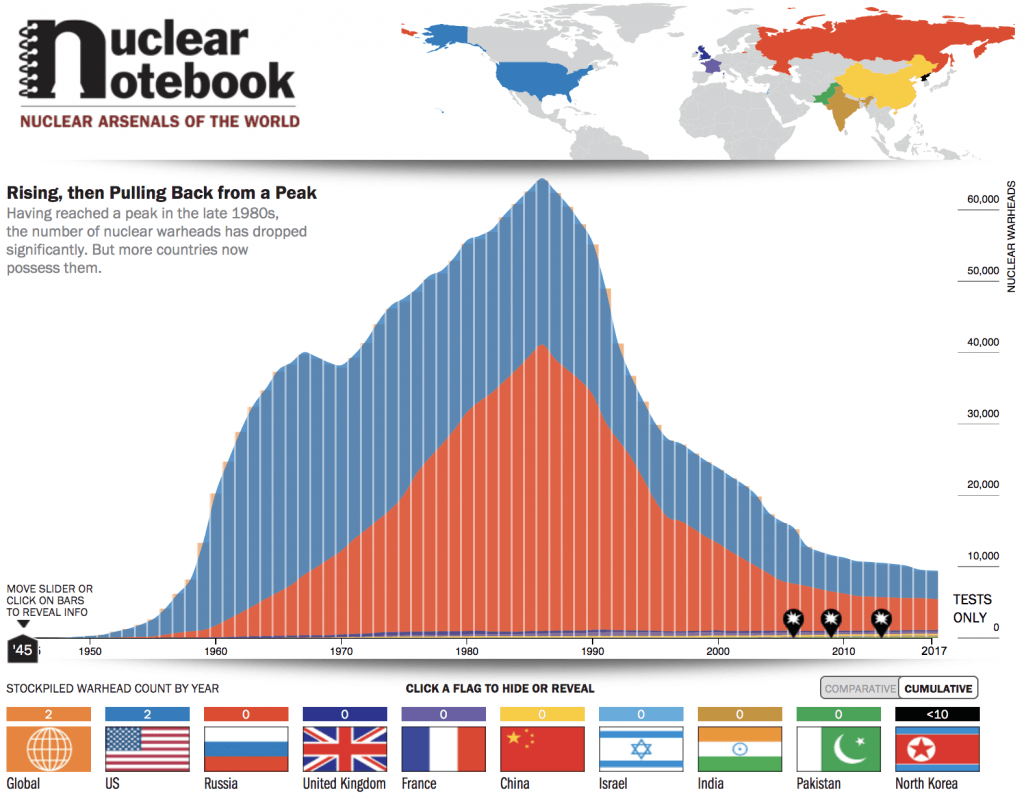Will nuclear proliferation challenges limit a significant expansion of global nuclear power?
By Vladimir Kobezskii, Elliot Serbin | June 20, 2019

Beyond safety and security concerns, nuclear technologies pose proliferation risks. Nuclear technologies are dual-use; that is, they can be used for both civilian and military purposes. The domestic development of an ostensibly peaceful nuclear power program and the enrichment facilities needed to fuel it can provide the means for a non-nuclear weapons state to create nuclear weapons. Because nuclear power has significant benefits as an energy source, particularly in regard to the fight against climate change, and has a valuable role in other industries, such as nuclear medicine, it is important that the international community continue to manage proliferation risks in emerging nuclear countries.
To build a nuclear weapon, one must first obtain bomb fuel—that is, uranium with its uranium 235 component enriched to 90 percent or more, or weapons-grade plutonium. The same centrifuges that enrich natural uranium to the level suitable for use in nuclear reactors can also further enrich it to be useable in a nuclear weapon. Similarly, the civilian reactors that produce electricity can also provide a source of weapons-grade plutonium, if their spent fuel is reprocessed, ostensibly for recycling of plutonium as new fuel.
Any plan that advocates for the expansion of nuclear power must account for potential proliferation risks. To mitigate these risks, individual states and the international community should pursue policies in line with the following recommendations:
- From a technical standpoint, non-nuclear weapon states that seek nuclear power should be encouraged to adopt proliferation-resistant technologies designed to separate a state’s use of nuclear power from its access to nuclear materials. The concept of an open fuel cycle should be further developed, so countries with new nuclear power programs agree not to reprocess spent nuclear fuel, a course followed by the United States. From the Russian perspective, such a strategy would support the non-proliferation regime and be price efficient. However, it could ultimately slow down the development of reprocessing technologies needed to support the closed fuel cycle—which uses plutonium separated from spent nuclear fuel—being pursued in other countries. Further work on the closed fuel cycle in the context of the International Atomic Energy Agency’s International Project on Innovative Nuclear Reactors and Fuel Cycles (INPRO), as well as several national closed fuel cycle programs, could play a vital role in supporting the global non-proliferation regime.
- Furthermore, the modernization of reactor designs should be based on the development of water-cooled reactors such as Westinghouse’s AP-1000 and Rosatom’s VVER-1200, which provide energy production with significantly less generation of potentially weapons-useable material. Pressurized water reactors, boiling water reactors, and pressurized heavy-water power reactors, which constitute 98 percent of the worldwide nuclear reactor fleet, do not typically produce weapons-grade material and may remain suitable designs for limiting the risks associated with the back end of the fuel cycle. The next possible generation of the Russian VVER, VVER-SKD, is a fourth generation design that will likely even further reduce uranium consumption, ensuring greater utilization of the fertile U-238 and radioactive waste burnup.
- In a similar vein, the adoption of new domestic enrichment capabilities should be discouraged in favor of international fuel banks or on relying on international enrichment providers. Together with the development of weapon proliferation-resistant technologies, the “Build, Own, Operate” business model, exemplified by the Rosatom’s Akkuyu nuclear power plant contract in Turkey, should also form the basis of commercial nuclear power, allowing non-nuclear countries to use nuclear energy without having to store spent nuclear fuel and eliminate the need to build their own uranium enrichment capacity. From a US perspective, pursuing this policy would necessitate some changes to existing practices. The US establishes and approves its nuclear cooperation with other countries in accordance with Section 123 of the Atomic Energy Act of 1954. The nine nonproliferation criteria stipulated in Section 123 do not require a country to forgo domestic enrichment or reprocessing. We recommend that the United States adopt this requirement as a condition for nuclear energy cooperation, as was the case in the US-United Arab Emirates 123 Agreement of 2009, often known as the “gold standard” of US nuclear cooperation agreements.
- States should take measures to strengthen the international nonproliferation regime, which, in our view, has been mostly successful to date in managing the global proliferation risks. (For example, President John F. Kennedy predicted in 1963 that “15 or 20 or 25 nations” would soon have nuclear weapons. Today there are only nine nuclear weapons states.) Specifically, this would entail measures to strengthen the International Atomic Energy Agency’s (IAEA) mandate, including bolstering its safeguards function by making the adoption of the Additional Protocol a requirement for nuclear cooperation. The requirements for a country to sign a Comprehensive Safeguards Agreement as well as an Additional Protocol represents the “gold standard” of the IAEA’s nonproliferation regime. Universalizing the more stringent inspection protocols of the Joint Comprehensive Plan of Action (JCPOA) from the specific case of Iran to other states when renewing their safeguards commitments to the IAEA would also strengthen the IAEA’s global mandate, giving it more authority to inspect suspicious activity beyond declared facilities and to engage in continuous materials protection, control, and accounting. We note, however, that depending on the nature of the global expansion of nuclear power—that is, for example, if we see the spread of many smaller reactors to numerous new countries—the burden placed on the IAEA safeguards regime could be immense. In order to reap the benefits of the IAEA’s role in managing proliferation risks, any global nuclear power expansion would need to be accompanied by a commensurate increase in financing and resourcing the IAEA by member states.
- A plan to manage the proliferation risks of expanded nuclear power could also consider domestic political institutions and governance characteristics. Certain standards could be adopted for recipient states on the basis of World Bank assessments covering regulatory quality, corruption levels, and political stability, as has been suggested by Scott Sagan and Steven Miller. These “good governance” indicators could tell us something about the ability of the recipient state to safely and securely manage nuclear power and associated fuel cycle programs. Sagan and Miller point out that aspiring nuclear power states score lower than existing nuclear power states across the board on World Bank World Governance Indicators, indicating potential future security and proliferation concerns.The social science research on the impact of regime type on proliferation risks remains somewhat inconclusive. A number of studies find that regime type—whether autocratic or democratic—does not play a significant role in determining a state’s proclivity to seek nuclear weapons, while other studies find that particular types of non-democracies are more likely to value and seek nuclear weapons. Evidence in support of the latter point is sufficiently intriguing to warrant further consideration, particularly to understand which nuclear power states may be at a higher risk of breaking their nonproliferation obligations. For example, Sagan and Miller have found that states with low democracy scores are more likely to subvert their obligations, broadly speaking, with regard to the Nuclear Nonproliferation Treaty and IAEA safeguards agreements.
- Last, any comprehensive nonproliferation effort should address not only the means of proliferation but also the motives that may drive states to seek nuclear weapons after developing a latent capability. Addressing the proliferation risks solely through improved technology and safeguards will not be sufficient. Such improvements likely cannot completely eliminate the dual-use problem, and a determined proliferator will be able to forge ahead with militarization of nuclear power and fuel cycle programs regardless. Therefore, efforts should be made to change the incentive structure that can favor nuclear weapons acquisition. We understand this goal to be an aspirational, long-term one, though particularly salient now as the so-called “nuclear taboo,” which has been a key limiting factor on the non-pursuit and non-use of nuclear weapons in the atomic age, appears to be in retreat. If we assume that certain theories of proliferation hold true—that states pursue nuclear weapons under certain circumstances for, in part, the international prestige and bargaining power they confer—then we can encourage policies to mitigate and reduce the perceived utility and status-conferring effects of nuclear weapons. Such policies may include the nuclear powers reducing a reliance on nuclear weapons in defense policy and national security strategy and engaging more coherently and in good faith with the international humanitarian consequences movement, which has expressed rising frustration regarding a lack of movement toward disarmament.
The expansion of nuclear power could pose serious proliferation risks, but we believe that these risks can be managed. While a global expansion of nuclear power may provide existing non-nuclear weapons states with the means and motives to pursue a nuclear weapons program, these risks can be addressed adequately if the international community pursues policies that mitigate the technical, legal, and normative factors that most significantly drive the proliferation risks associated with commercial nuclear power. For this reason, we believe that the proliferation concerns should not be a decisive factor in limiting the expansion of nuclear power, especially given the potentially significant benefits of nuclear energy in regard to providing a large-scale reliable electricity source that helps combat climate change.
Together, we make the world safer.
The Bulletin elevates expert voices above the noise. But as an independent nonprofit organization, our operations depend on the support of readers like you. Help us continue to deliver quality journalism that holds leaders accountable. Your support of our work at any level is important. In return, we promise our coverage will be understandable, influential, vigilant, solution-oriented, and fair-minded. Together we can make a difference.
Topics: Analysis, Climate Change, Nuclear Energy, Voices of Tomorrow
















this is ridiculous. five commercial reactors have already exploded. tmi, fermi 1 and too many others have come close. given the sorry state of regulation and operation, more reactor explosions are virtually inevitable.
atomic energy is a dead technology and a technology of death. it cannot even come close to competing with renewables. this idea of cooling the planet with 440 atomic cores in the 300C range is patently insane.
give it up!
The authors fail to list even one of what they claim are “potentially significant benefits” of nuclear power, because there aren’t any. Nuclear power threatens catastrophic and global radiation releases; adds every day to background radioactive pollution through allowable releases of radioactive gases and effluents; produces deadly and unmanageable radioactive wastes that will cost hundreds of billions of dollars to package and repackage for up to a million years; continues its long history of unsuccessful containment of its radioactive waste, causing cancers, immune deficiencies, and other illnesses that can be pass to offspring endlessly; threatens to bankrupt reactor owners and… Read more »
Meanwhile coal kills 8 million a year. https://www.seas.harvard.edu/news/2021/02/deaths-fossil-fuel-emissions-higher-previously-thought